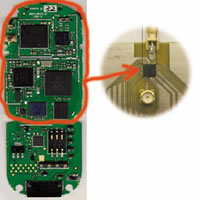







Four key components make up most cellular radio systems: the
cellular layout itself, a carefully engineered network of radio base
stations and antennas, base station controllers which manage several
base stations at a time, and a mobile switch, which gathers traffic from
dozens of cells and passes it on to the public switched telephone
network.
All analog and digital mobiles use a network of base stations and
antennas to cover a large area. The area a base station covers is called
a cell, the spot where the base station and antennas are located is
called a cell site. Viewed on a diagram, the small territory covered by
each base station appears like a cell in a honeycomb, hence the name
cellular. Cell sizes range from sixth tenths of a mile to thirty miles
in radius for cellular (1km to 50km). GSM and PCS use much smaller
cells, no more than 6 miles (10km) across. A large carrier may use
hundreds of cells.
Each cell site's radio base station uses a computerized 800 or 1900 megahertz transceiver with an antenna to provide coverage. Each base station uses carefully chosen frequencies to reduce interference with neighboring cells. Narrowly directed sites cover tunnels, subways and specific roadways. The area served depends on topography, population, and traffic. In some PCS and GSM systems, a base station hierarchy exists, with pico cells covering building interiors, microcells covering selected outdoor areas, and macrocells providing more extensive coverage to wider areas. See the Ericsson diagram below.
The macro cell controls the cells overlaid beneath it. A macro cell often built first to provide coverage and smaller cells built to provide capacity.

The circuit board is the heart of the system. Here is one from a typical Nokia digital phone:
 The front of the circuit board |
 The back of the circuit board |
In the photos above, you see several computer chips. Let's talk about what some of the individual chips do. The analog-to-digital and digital-to-analog conversion chips translate the outgoing audio signal from analog to digital and the incoming signal from digital back to analog. You can learn more about A-to-D and D-to-A conversion and its importance to digital audio in How Compact Discs Work. The digital signal processor (DSP) is a highly customized processor designed to perform signal-manipulation calculations at high speed.
The microprocessor handles all of the housekeeping chores for the keyboard and display, deals with command and control signaling with the base station and also coordinates the rest of the functions on the board.
 The microprocessor |
The ROM and Flash memory chips provide storage for the phone's operating system and customizable features, such as the phone directory. The radio frequency (RF) and power section handles power management and recharging, and also deals with the hundreds of FM channels. Finally, the RF amplifiers handle signals traveling to and from the antenna.
 The display and keypad contacts |
The display has grown considerably in size as the number of features in cell phones have increased. Most current phones offer built-in phone directories, calculators and games. And many of the phones incorporate some type of PDA or Web browser.
 The Flash memory card on the circuit board |
 The Flash memory card removed |
Some phones store certain information, such as the SID and MIN codes, in internal Flash memory, while others use external cards that are similar to SmartMedia cards.
 The cell-phone speaker, microphone and battery backup |
Cell phones have such tiny speakers and microphones that it is incredible how well most of them reproduce sound. As you can see in the picture above, the speaker is about the size of a dime and the microphone is no larger than the watch battery beside it. Speaking of the watch battery, this is used by the cell phone's internal clock chip.
What is amazing is that all of that functionality -- which only 30 years ago would have filled an entire floor of an office building -- now fits into a package that sits comfortably in the palm of your hand!